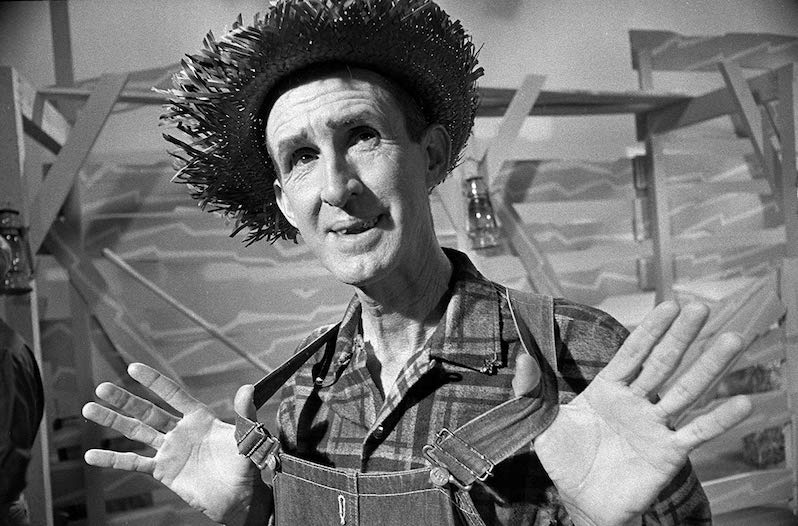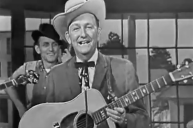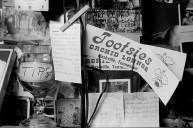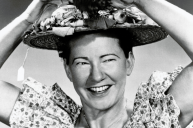On Nov. 11, 1973, Louis Marshall "Grandpa" Jones drove 30 minutes north of Nashville to a small cabin. Jones intended to pick up his friend and Grand Ole Opry legend David "Stringbean" Akeman for a hunting trip in Virginia.
But what he found shattered Nashville's sense of security and, in a way, forever shut the door on a unique way of American life.
Stringbean's Humble Roots
David Akeman grew up poor on the family farm in the small town of Annville, in Jackson County, Kentucky. And if that already sounds cliché, just wait. He fashioned his first banjo at age 7 from a shoebox and borrowed thread. Music ran in the family, and so his family encouraged his music.
At age 12, he traded in a pair of prize chickens for a real banjo, eventually gigging around town. Of course, during the Great Depression, no kid made enough money playing music. So, Stringbean worked for the New Deal-era Civilization Conservation Corps, which was responsible for building roads and planting trees.
But Akeman's passion and talent eventually landed him in a talent show judged by Asa Martin. Martin was so impressed by Akeman's young banjo playing talent that he invited him to play some shows with his band. It was there he earned his iconic nickname, mostly thanks to a forgetful band leader.
Stumbling over Akeman's real name, the bandleader called out for "Stringbean," a comical nod to Akeman's lanky, 6' 5" frame. Akeman loved it, and Stringbean stuck for the rest of his life.
Interestingly enough, Stringbean's biggest musical break came by way of semi-pro baseball — a favorite career path of several country stars of the time. Bluegrass giant Bill Monroe owned a rival baseball club. After seeing Stringbean sling fastballs on the diamond, Monroe inquired about the pitcher — only to eventually find he was a musician.
So Akeman honed his chops with Monroe from 1943 to 1945 until eventually parting ways. Monroe would eventually hire a young Earl Scruggs, who revolutionized the instrument Stringbean had such classic reverence for.
A Modest Opry Star
During his time with Monroe, Akeman fell into a comedy gig, thanks to the absence of another performer. He joined with Willie Egbert Westbrook to form String Beans and Cousin Wilbur, a comedy act that performed during the mid-show break in Monroe's set.
Stringbean eventually worked on his comedy craft to revive the "banjo comedians" of old. (Sure, in a way you could say Steve Martin and Ed Helms are continuing that same tradition). He eventually dressed in his signature outfit, a look said was inspired by one of his heroes and fellow banjo player, Slim Miller.
Stringbean tucked an extra-long shirt into a particularly small pair of pants. Pants so small, he had to borrow them from his tiny physical antithesis, Little Jimmy Dickens. He fastened them around the knees and created a look that was so simply dumb yet so sublimely funny.
Stringbean formed a strong bond with arguably the first Opry superstar, Uncle Dave Macon. Both Stringbean and Macon felt a strong connection to old-time clawhammer banjo and a certain rural, simple way of life.
Macon brought Stringbean into the Opry and took him under his wing. When Macon passed away in 1952, Stringbean was the obvious choice to take his spot. From there, his legend grew. Though he wouldn't record his own solo material until a decade later, Stringbean played with and recorded for countless country stars.
In 1969, Akeman's star grew brighter as a recurring cast member on the now-infamous show Hee Haw. He often reprised his role as the beloved Scarecrow character and as a country bumpkin in a "Letters From Home" skit.
An Old Habit Breeds A Terrible Consequence
Akeman had officially made a storied career essentially out of two prize chickens. But despite his success, he was still a simple man. Along with his bride Estelle Stanfill, Akeman lived in a rural cottage away from the hustle and bustle of Nashville, Tennessee.
Neither of them indulged in any of life's excess, instead opting for simpler pleasures. However, he did splurge on one luxury. Every year, he bought the newest model of Cadillac. It was a peculiar purchase, considering Stringbean couldn't drive. But it suited Estelle quite well and carried them on their weekly 30-minute journey to the Grand Ole Opry every Saturday night.
But being a Depression-era guy, Akeman also supremely distrusted banks. Ever since he was young, he kept his money in his overalls. When success came, Stringbean still kept his cash — sometimes rolled up in the thousands of dollars, in a tightwad on the front of his overalls. He was known to flash the roll a time or two.
That little habit would ultimately lead to his demise.
A woman who worked for Stringbean's booking agency casually let slip the rumor that he kept all his cash hidden at his cottage. Her husband Charlie Brown (yes, really) told his brother Doug and cousin John, who schemed a way to get the cash.
Unfortunately for Stringbean, his regular appearance on the Opry made his whereabouts every Saturday night pretty well known for potential burglars.
A Senseless Murder
On Saturday, Nov. 10, 1973, Stringbean made his appearance at the Opry as usual. Unbeknownst to him, John and Marvin Douglas Brown were rummaging through his house at the very moment Stringbean was performing his last song. They were listening to the broadcast live on the radio.
The Brown cousins turned the place over but found nothing. Upset, the 23-year-old John convinced Doug to wait with him for Stringbean and Estelle to return. They planned on forcing him to show them where he hid his money.
When Stringbean and Estelle arrived at their Ridgetop, Tenn. home, he noticed something wrong about the scene. He set his banjo on the porch and approached the cabin with his own pistol drawn, surprising Doug Brown immediately inside the doorway. But before he could act, John Brown approached and shot Dave Akeman at point-blank range.
Hearing the gunshots, Estelle Akeman fled the car to get help. But John A. Brown ran her down in the field in front of the house, executing her from behind in the back of the head. They left the house with only a chainsaw and some firearms.
Nashville Changed Forever
After Grandpa Jones reported the horrific site to the police the next morning, the entire country music world set ablaze. After hundreds of tips, it didn't take long to find the Akemans' killers. But the damage to the Music City community had been done with the death of Stringbean and his wife.
Nashville no longer felt neighborly. Country stars no longer felt safe to carry about carelessly with other townsfolk. Over the next several years, security and private estates trumped the old-fashioned way of life Akeman clung so dearly to.
A certain piece of history died with Stringbean. And America again felt a shocking loss of innocence. It was like the death of Buddy Holly, or the Manson Family murders all over again.
Stringbean's legacy lived on, however, in the show Hee Haw, which is what he was best known for. An entire season featuring Akeman had already been taped, so he appeared alongside the rest of the cast a year after his brutal killing. Finally, Grandpa Jones addressed the tragic loss in a moving tribute to his friend and colleague on the show.
https://www.youtube.com/watch?v=T9EAUms4XIg
The Browns were sentenced to two consecutive 99-year sentences. Doug died in prison in 2003, and John gained parole in 2014. Though he had been denied by the parole board time and time again, Brown felt freedom after 41 years of rehabilitation.
Every day on the anniversary of the murders, Brown fasts and prays. Fellow inmates and correctional officers say Brown eventually became an extremely positive influence on other prisoners and expresses a profound sense of guilt for what he did.
Dave "Stringbean" Akeman captured a truly forgotten way of life, in his person and his playing. Sadly, much of that way passed with Akeman as the '70s ushered in the first wave of a new country sound and classic characters were relegated simply to caricatures on Hee Haw.
Stringbean and his wife Estelle's story has become a piece of country music folklore, and was even recounted in Sam Bush's 2009 song, "The Ballad of Stringbean and Estelle." They were buried in Forest Lawn Memorial Gardens in Goodlettsville, Tennessee. But it's important to remember what Akeman achieved through his humility and humor. Like the man himself, his place in country music history is truly one of a kind.
This article was originally published in 2018.




